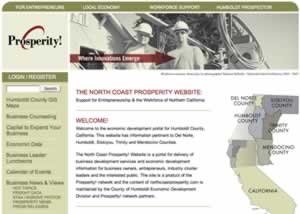by Bob | Feb 18, 2009 | Local Tech Notes, Open Source Web Development
What a strange sounding title to a post. But this is just to point out that the new site Recovery.gov released to track the recovery plan is built with Drupal, a content management system and framework that we have been using more and more. In fact, we’re in the process of making our own site over in Drupal, and we’ve just become a partner with Acquia which proivdes professional support services for Drupal users and developers.
Anyway, this use by the Obama administration of Drupal is a big deal. It’s a big deal for Drupal itself, but it’s also a big deal as a stamp of approval for the open source movement in general. This article points out some of the roots of the cross pollination of the open source, Drupal and Deomcratic party politics.
by Bob | Mar 6, 2008 | Local Tech Notes, Open Source Web Development
We recently completed an upgrade to the Redwood Technology Consortium web site. A few years ago we converted the site from a proprietary Cold Fusion system to the open source Drupal platform. We felt it was time to upgrade since the site was running on a 4.x version of Drupal. 5.x had been out for a while and all the modules we needed had also been upgraded to the current version. While we were working on the upgr ade, Drupal released version 6 while progress on version 7 proceeded on a fast pace. All this to say I am glad that we went down the Drupal path. Development on the platform is rapid and core improvements and module development is quite intensive
ade, Drupal released version 6 while progress on version 7 proceeded on a fast pace. All this to say I am glad that we went down the Drupal path. Development on the platform is rapid and core improvements and module development is quite intensive
While for the most part visitors to the site won’t notice much difference since the upgrade, back end functionality is much improved. The system allows multiple users with the proper access privileges to maintain the content and that hasn’t changed. The original design by Carson Park Design remains the same as well.
During the upgrade we did move member management to a major module suite called CiviCRM. This will allow for much easier joining, renewal and display of members. For an all volunteer organization, anything that streamlines the process is a huge benefit.
by Bob | Feb 25, 2008 | Local Tech Notes, Open Source Web Development
It’s been a long road, but a couple weeks ago we got the OK to launch the new Adventure’s Edge web site. We’re pretty proud of this project because of the various tools we either built or incorporated in to the site.
We’re quite proud of the design. It’s simple and straightforward, but with the Flash on the home page and some dynamic tools, it’s a vast improvement over their old site.
 We used our own in-house content management system for most of the site. But we integrated WordPress in to the design as a blogging tool. Not only has the design been integrated, but we also made recent blog post titles availabe on the home page and on the various department pages.
We used our own in-house content management system for most of the site. But we integrated WordPress in to the design as a blogging tool. Not only has the design been integrated, but we also made recent blog post titles availabe on the home page and on the various department pages.
We also built a tool to highlight all the brands they sell, and when they get their new online store up and running, the brand names will link directly to the store categories for those manufacturers.
BTW, Adventure’s Edge is now under new ownership with some new people helping to run the show and they seem very enthusiastic about making the site useful and effective for their customers.
by Bob | Feb 10, 2008 | Local Tech Notes, Open Source Web Development
After about a year and a half of struggle we finally unveiled the third version of the Prosperity! Network’s new web site. The saga of this project is a good example of design by committee that is the death of many projects and results in cost overruns on many others. In spite of some valiant efforts to define the goals and features of the site from the beginning, the project kept morphing. There literally was a committee behind the effort, but the make-up of the committee changed from meeting to meeting. Eventually, the county hired someone (Angie Schwab) dedicated to get the project done and that is what she did.
Our role has been to try and advise the Prosperity folks on what can and can’t be done within the project’s budget and to find the best technology to implement what they finally decided on for the site. Early on we chose to build the site  using the Drupal platform. At one point, though, during the murkiest time in the development process we suggested abandoning Drupal for something simpler. But the decision was made to go forward with Drupal and for now, that seems to have worked out.
using the Drupal platform. At one point, though, during the murkiest time in the development process we suggested abandoning Drupal for something simpler. But the decision was made to go forward with Drupal and for now, that seems to have worked out.
Sometimes working with Drupal is like trying to solve a Rubick’s cube puzzle. One move affects all the other squares and their relationships. So, you might start down a path thinking you are making all the right moves. But then a new feature request comes in, you install a new module and that module doesn’t play nice with something else you’ve installed. Fun. Still, Drupal is the most feature rich, flexible platform we have found in the open source world. I think Drupal will serve them for some time.
by Bob | Oct 13, 2006 | Local Tech Notes, Open Source Web Development
So if you have read previous posts in this series, you know we’ve moved in to the Drupal realm and seem committed to the path. We have lots of modules installed and configured. Now, even while the site is live we are looking at refining what we have and further customizing the site.
Drupal has an amazing amount of flexibility. Understanding the core features and vocabulary can take some time but is well worth the effort. The Drupal Handbooks are a great resource.
Going beyond the basics can be even more daunting. This series of articles goes into even more detail on the same process we went through in deciding what open source software to use. Also, the articles go much further in providing technical details in to creating templates (how the site looks) and modifying modules.
Finally, while I think Drupal is an excellent solution for some situations I am not convinced it works for every project. While Drupal’s flexibility and extensibility are impressive, many organizations simply want an easy to use and easy to undertand system for maintaining content. And the specific requirements for some prjects do not easily fit in to the logic and structure that an all encompassing system like Drupal offers. Drupal and other systems force you to fit your concepts to their structure. The time needed to make that happen can be extensive. We have been facing that problem with another project we’ve been struggling with for quite a while.
To satisfy the needs of some clients, we have built our own CMS that we can deploy quickly and can be modified easily to accomodate specific needs. For some clients this is a much better solution. The interface is simple and straightforward. The tools are obvious and accessible.
For yet other projects, I have found WordPress to be an ideal solution. It can be set up in 10 minutes. And, like Drupal, has a long list of add-ons that can be used to easily extend its capabilities.
My conclusion is that no single solution will work for all situations. And one of the problems with systems like Drupal is the attempt to be that single solution which means wading through pages and pages of documentation and modules to find just the right tools that meet a specific need. Sometimes simple is simply better.
by Bob | Sep 7, 2006 | Local Tech Notes, Open Source Web Development
In previous posts on this topic I covered the reasons for using an open source content management system for the new Redwood Technology Consortium site and the process we went through in planning and choosing a system.
One of the core concepts of the open source CMSs I have looked at is their modularity. That is each system comes with a core set of features and then a long list of plugins or modules that can be added that extend the featureset of the site. These add-ons can include enhancements to existing features or completely new functions. Some add-ons are designed soley to allow integration of other open source systems that have been developed totally outside the core community. Examples of add-ons might include forums, shopping carts, elaborate contact management systems or photo galleries.
Many modules are created by third party developers and freely contributed to the CMS community. Drupal (which we used for the Redwood Technology Consortium site) has a long list of modules. This extensibility is one of the advantages of these open source packages. New modules are added all the time. And existing modules can be modified and themselves extended. A challenge in working with these systems is knowing what add-ons are the most appropriate for the particular task to be accomplished. Looking at the list of module descriptions in Drupal can be confusing. It’s often difficult to know exactly how one works from the description. It really becomes necessary to get involved in the Drupal community to learn more about modules, their functions, strengths and weaknesses.
Also, as the core package changes from one version to another, modules are not always updated to work with the new version. For example, the latest major release of Drupal is numbered 4.7. But some well developed modules only work for version 4.6. So, depending on the needs of the site you may have to make a choice between using an older version of the system with the modules you need already available, or use the latest version and either make do what what modules are availabe or write new ones.
In the case of the RTC site we found pretty much everything we needed in 4.7. But since then, on other sites we’ve started working on, this issue has become very important. Writing or modifying modules can take extra time and therefore raises the cost of the project.
One issue we did run across with the RTC site is trying to translate what the organization calls a member to what Drupal calls a member and make the two work together. Membership in a Drupal site is specific to how Drupal works. But this has only limited application to what membership means to RTC. We are still trying to work out this interface.
A drawback we have found in the Drupal system is the weakness or underdevelopment of ecommerce modules. Perhaps we haven’t found just the right module. Or perhaps there is an opportunity for a richly featured and easy to use ecommerce module.
Another weakness in the current stable release of Drupal is the integration of the WYSIWYG (What You See Is What You Get) content editor. This allows non-technical users to create and edit content without having to know or use any code for controlling the display of content. Drupal uses a third party Open Source module (called TinyMCE) that needs to be installed in two stages, one using a Drupal integration module and the other the installation of the third party module itself. But even that doesn’t complete the steps. You also need to integrate an image upload tool that allows the user to insert images into their web pages easily.
Finally, going forward, as Drupal evolves, some modules become incorporated into the core package, while others will need to be updated by the individual developers. This makes moving from one version to another a non-trivial matter. Some modules are updated quickly and easily while other suffer long delays. Unless you have the time and expertise to upgrade your installed modules to work with the newest version, you remain at the mercy of the module developers as far as migrating from one release to another.
So, while this extensibility and modularity has some tremendous advantages, careful research and planning needs to be built in to the management of any project based on them. It’s easy to throw up a basic site with any of several of these systems. But if your project has very specific needs that are not met by the core system or a module doesn’t work exactly as your site needs expect to either modify your site plan to match how things work, or to get your hands dirty modifying or writing new code to suit your needs.



 using the
using the